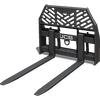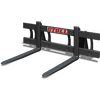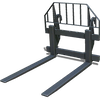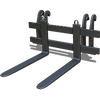Pallet Forks/Farming Simulator 17
A Pallet Fork is a type of Loading Tool in Farming Simulator 17. Pallet Forks feature two tines (teeth) that can easily slide into the holes at the bottom of a Pallet and lift it up. They can also be stabbed into Bales and lifted without too much difficulty.
The base game offers four different models of Pallet Forks. Each model is designed to be fitted on a different type of Loader. The carrying vehicle can have a huge impact on the usefulness of the tool, because work with Pallets and Bales often requires a high degree of precision. Some Loaders are specifically built for this sort of precision, while others are not. Other than this, the Pallet Forks themselves are virtually identical to one another in terms of performance.
List of Pallet Forks
The following is a list of all Pallet Forks found in the base game. Note that each Pallet Fork is found in a different category at the Store, and can only be fitted to one specific type of Loader.
Common Features: $5 Maintenance Cost per Day
| Name | Price | Weight | Attachment |
|---|---|---|---|
| JCB Pallet Fork | 700 | 267 | Skid Steer Loader |
| Stoll Pallet Fork | 800 | 189 | Front Loading Arm |
| Magsi Telehandler Pallet Fork | 1,200 | 173 | Telehandler |
| Magsi Wheel Loader Pallet Fork | 1,900 | 398 | Wheel Loader |
Working with Pallet Forks
The primary purpose of Pallet Forks is to lift Pallets. Pallets themselves are designed with a pair of large holes specifically so that a Pallet Fork could easily slide into the Pallet and provide stable lifting. Learning to properly lift Pallets with a fork is essential in Farming Simulator 17, because some essential materials (particularly Seeds) can only be bought in Pallet form.
To lift a pallet and unload it elsewhere, follow these steps:
- Align your Pallet Fork to be perpendicular to the holes in the Pallet.
- Ensure that the Pallet Fork is completely horizontal.
- Lower the Pallet Fork so that its tines are at the same height as the Pallet's holes.
- Drive forward until the back plate of the Pallet Fork touches the Pallet's wooden base.
- Lift the Pallet Fork.
- At this point you might want to tilt the Pallet Fork upwards. This will reduce the chance that the Pallet will fly off the fork during sharp turns or abrupt deceleration.
- Drive to where you want to drop the Pallet, and align it in the exact orientation you want to place it in.
- Tilt the Pallet Fork until it is completely horizontal.
- Lower the Pallet Fork until you can see that the Pallet is just barely resting on the ground or whatever object you're placing it on.
- Lower the Pallet Fork a little bit more, to release the Pallet.
- Reverse away from the Pallet. The Pallet Fork should slide out of the Pallet cleanly.
This procedure takes some skill, but with the right Loader it can be very easy. Of particular note are Skid Steer Loaders and Telehandlers, which have excellent steering systems and can help you place the pallet down exactly where you want it. Large Loaders, especially Wheel Loaders, are far too large and hard to steer to do this properly - but a skilled driver can use them nonetheless.
Try to avoid lifting the Pallet above your vehicle, if at all possible. If you want to place it high up above the ground (such as on top of a stack of other Pallets), only lift it once you've reached you're done maneuvering and are ready to place it. Pallets are very heavy, so keeping the Pallet low to the ground while moving will significantly reduce the chance of your vehicle tipping over due to the weight imbalance. This is more of an issue with light vehicles, e.g. a Skid Steer Loader or Tractor, as their own weight is often too low to counterbalance the weight of the Pallet itself.
Lifting Bales
In addition to Pallets, a Pallet Fork is also capable of lifting Bales of any shape. The tines of a Pallet Fork can slide easily into Bales at almost any angle, much as a dedicated Bale Fork would.
The tines of a Pallet Fork are somewhat wider and less sharp than the tines of a Bale Fork, and may not slide in so easily when "attacking" the bale from an unusual angle. However, when the fork is aligned with the pallet correctly, it should slide in with ease.
Lifting Bales works much the same way as lifting Pallets (see above), with two differences:
- There's usually less need for precision when working with Pallets. Nevertheless, if you stab the Pallet Fork into the bale at an odd angle, you increase the chance that the Bale will not be securely held by the tines, and may fall off during any sudden maneuver. For a more precise and effective tool, replace the Pallet Fork with a Bale Fork or a Bale Handler.
- It is harder to release a Bale once you've placed it at the drop-off point. To encourage the Fork to slide out of the Bale, try pressing the bale down so that the friction between it and the ground (or whatever object it is resting on) will hold it in place as the fork is pulled out.




